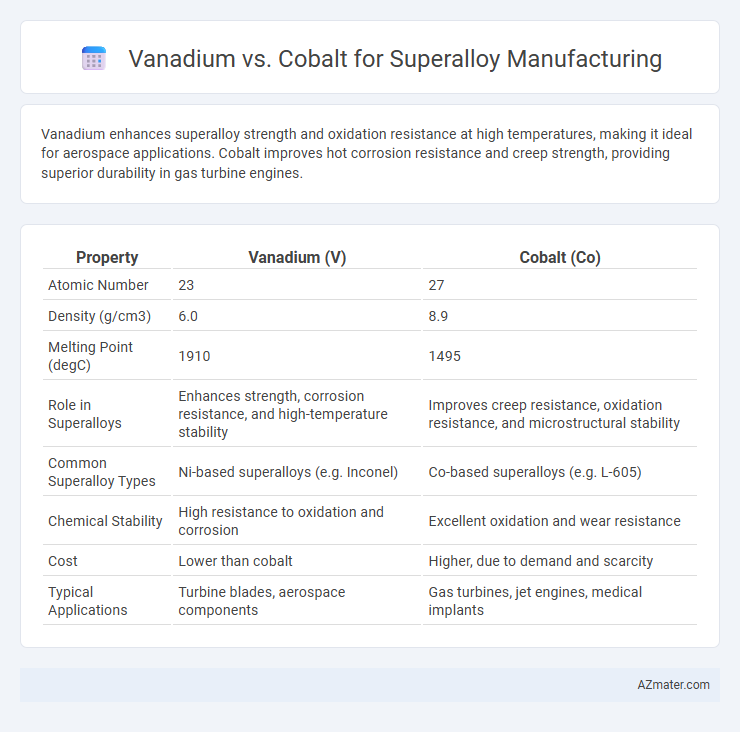Vanadium enhances superalloy strength and oxidation resistance at high temperatures, making it ideal for aerospace applications. Cobalt improves hot corrosion resistance and creep strength, providing superior durability in gas turbine engines.
Table of Comparison
| Property | Vanadium (V) | Cobalt (Co) |
|---|---|---|
| Atomic Number | 23 | 27 |
| Density (g/cm3) | 6.0 | 8.9 |
| Melting Point (degC) | 1910 | 1495 |
| Role in Superalloys | Enhances strength, corrosion resistance, and high-temperature stability | Improves creep resistance, oxidation resistance, and microstructural stability |
| Common Superalloy Types | Ni-based superalloys (e.g. Inconel) | Co-based superalloys (e.g. L-605) |
| Chemical Stability | High resistance to oxidation and corrosion | Excellent oxidation and wear resistance |
| Cost | Lower than cobalt | Higher, due to demand and scarcity |
| Typical Applications | Turbine blades, aerospace components | Gas turbines, jet engines, medical implants |
Overview of Superalloys: Importance in Modern Industries
Superalloys, critical in aerospace, power generation, and automotive industries, are engineered for exceptional strength, corrosion resistance, and stability at high temperatures. Vanadium and cobalt serve as key alloying elements, with vanadium enhancing grain refinement and high-temperature strength, while cobalt improves corrosion resistance and phase stability. The choice between vanadium and cobalt in superalloy manufacturing directly impacts material performance in extreme environments, influencing durability and efficiency.
Vanadium and Cobalt: Elemental Properties and Characteristics
Vanadium exhibits excellent high-temperature strength, corrosion resistance, and oxidation stability, making it a critical element in superalloy manufacturing to enhance alloy hardness and structural integrity. Cobalt offers superior thermal stability and maintains strength at elevated temperatures, contributing to improved creep resistance and durability in superalloys used for extreme environments. The elemental characteristics of vanadium, including its ability to form stable carbides, complement cobalt's magnetic properties and high melting point, resulting in superalloys optimized for aerospace and turbine blade applications.
Mechanical Strength: Vanadium vs Cobalt
Vanadium significantly enhances mechanical strength in superalloys by refining grain structure and promoting precipitation hardening, resulting in improved high-temperature stability and resistance to creep. Cobalt contributes to strength by increasing alloy density and solid-solution strengthening, which also aids in oxidation and corrosion resistance at elevated temperatures. The choice between vanadium and cobalt depends on the specific strength requirements and operational environment of the superalloy application, with vanadium favored for structural integrity and cobalt for overall durability.
High-Temperature Performance Comparisons
Vanadium enhances superalloys by improving high-temperature strength and oxidation resistance, making it ideal for turbine blades operating above 800degC. Cobalt-based superalloys exhibit superior hot corrosion resistance and maintain structural integrity at temperatures exceeding 1000degC, favored in jet engines and gas turbines. The choice between vanadium and cobalt hinges on balancing thermal stability with environmental durability in extreme aerospace applications.
Corrosion and Oxidation Resistance in Superalloys
Vanadium and cobalt play critical roles in enhancing the corrosion and oxidation resistance of superalloys used in high-temperature applications. Vanadium additives improve the formation of stable oxide scales such as vanadium oxides, which act as protective barriers against oxidative degradation. Cobalt contributes to the superalloy's strength and stability while forming a dense, adherent oxide layer primarily composed of cobalt oxide, which significantly reduces oxidation rates and enhances resistance to corrosive environments.
Cost and Material Availability Analysis
Vanadium offers a cost-effective alternative to cobalt in superalloy manufacturing, with prices significantly lower due to its more abundant global reserves concentrated primarily in countries like China, Russia, and South Africa. Cobalt's limited availability and geopolitical supply risks, primarily sourced from the Democratic Republic of Congo, contribute to its higher price volatility and procurement challenges. The abundance of vanadium supports more stable supply chains and lower raw material costs, making it increasingly favorable for high-performance superalloy applications where cost efficiency is critical.
Environmental Impact: Extraction and Processing
Vanadium extraction typically involves mining of magnetite and vanadiferous titanomagnetite ores, which can lead to significant landscape disruption and potential water contamination due to tailings and processing chemicals. Cobalt is often a byproduct of copper and nickel mining, frequently sourced from the Democratic Republic of Congo, where mining practices raise serious concerns about environmental degradation and human rights violations. Processing both vanadium and cobalt requires energy-intensive refining, with cobalt refining posing higher risks for toxic emissions and hazardous waste, making the overall environmental impact of cobalt extraction and processing more severe compared to vanadium.
Alloying Behavior: Compatibility with Other Elements
Vanadium exhibits strong compatibility with elements such as aluminum, chromium, and titanium, promoting the formation of stable carbides and intermetallic phases that enhance high-temperature strength and oxidation resistance in superalloys. Cobalt, on the other hand, provides superior solubility with nickel and chromium, improving phase stability and creep resistance in cobalt-based superalloys while enabling fine-tuning of microstructural properties. The alloying behavior of vanadium and cobalt significantly influences the mechanical performance and thermal stability of superalloys by controlling carbide morphology and phase transformations during service.
Application-Specific Suitability: Aerospace and Energy
Vanadium exhibits superior high-temperature strength and oxidation resistance, making it ideal for aerospace turbine blades and jet engines requiring exceptional thermal stability. Cobalt alloys provide excellent wear resistance and corrosion protection, favored in energy sector components like gas turbines and nuclear reactors exposed to harsh environments. Selecting between vanadium and cobalt depends on the application's thermal endurance requirements and operational corrosion challenges within aerospace and energy industries.
Future Trends in Superalloy Development
Vanadium and cobalt play crucial roles in superalloy manufacturing, influencing high-temperature strength and corrosion resistance in aerospace and energy sectors. Future trends highlight increased use of vanadium for its lightweight and oxidation-resistant properties, while cobalt remains vital for its exceptional thermal stability and phase stability in complex superalloy matrices. Advances in additive manufacturing and high-entropy alloys are driving research toward optimizing vanadium-cobalt ratios to enhance performance and sustainability in next-generation superalloys.

Infographic: Vanadium vs Cobalt for Superalloy Manufacturing
 azmater.com
azmater.com